 How it all began
How it all beganHalf way through a degree at the University of Wollongong. Eleanor was faced with a tough future as an aspiring artist. 'Every day of my training our teachers would tell us that more than half of us would never survive in the entertainment industry. When I met graduates of drama schools they all seemed to be working in cafes and waiting on a call from their agent. The people who were succeeding all had something extra special about them that set them out of the crowd. I knew that I needed to find that special something'
For a long time Eleanor planned on becoming an opera singer but came to realise that it didn't suit her, so continued her search.
By luck, Eleanor's path crossed with four very special people, all of them were Vietnamese...
The first was a young academic named Thi (Nguyen Dinh Thi) from the Hanoi Institute of Theatre and Film. He came to Australia to study for his PHD in theatre at Eleanor's University. During his study he also co-directed 'The Land of Bliss', based on a Vietnamese folk tale 'Thu Thuc gap tien' (Thu Thuc meets a fairy), a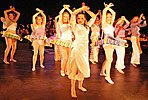 production that combined both Australian and Vietnam theatrical modes. It involved martial arts, Vietnamese and modern dance and singing in Vietnamese. In this production Eleanor played multiple roles including a warrior, a fairy and a river spirit.
production that combined both Australian and Vietnam theatrical modes. It involved martial arts, Vietnamese and modern dance and singing in Vietnamese. In this production Eleanor played multiple roles including a warrior, a fairy and a river spirit.
'Up until that point I had never enjoyed performing so much! It was a lively, beautiful, creative show and it was a sell out which is quite peculiar for a University production. I loved the poetry of Vietnamese performance and I also was able to draw on my previous years of martial arts training to choreograph the fighting scenes.'
The influence this show had on Eleanor had started a fire burning inside of her, but there were yet more influence to come...
'The first time I met Binh (Ta Duy Binh) I could tell that he was something special. Quite short, but extremely agile, with an entensity that fills the stage'
He came to Wollongong University to teach the acting students Chi Cung, a Vietnamese form of meditation. Eleanor later learned that he had trained as a mime actor in Hanoi many years ago and had recently been back to Hanoi to learn an ancient form of the theatre. Intrigued, she went to the presentation of his video which showed him performing the ancient art form Tuong.
'As I watched the performance my heart started racing. He performed a piece called ' ' (someone crosses the river). It involved a character walking along the river carrying a basket, he suddenly hears cries of distress at he know that in order to help the one in distress in most cross the river. So he uses the basket as a boat to cross. A very simply story, but performed with such wonderful physicality. I remember thinking to myself that if only I could learn this I would have a skill that would equipt me to compete 100 times stronger than I did at the time.'
Noticing Eleanor's enthusiasm for the Vietnamese arts, Binh invited her to join him at Citymoon Theatre Company to perform in the production 'Eleven Parts of Feeling'. This was another production that combined the Vietnamese and Western modes, and another hugely successful show. It was there that Eleanor met an other big influence... Dang Lan.
Dang Lan had been in Australia for over 30 years now. But back in Saigon, she was a star, enjoying one of the top selling albums of her time. In Sydney Australia she was well known amongst the Vietnamese community and continued to perform regularly. When Eleanor and Dang Lan met, they quickly formed a very close friendship.
'We often joke that we must have been sisters in a past life because we are so alike.'
Dang Lan taught Eleanor a number of Vietnamese folk songs including 'Qua Cau Gio Bay' (Crossing the Bridge Gone with the With) and Cay Chuc Xinh (The Beautiful Bamboo Tree). And Eleanor made her debut singing Vietnamese folksongs for Vietnamese audience at a fundraising night for Koto.
'I remember being so nervous singing in Vietnamese for Vietnamese audiences, I didn't know how they would react to a westerner singing their traditional songs. But the result was breath taking; after singing the first line of the song, the entire audience began to applaud. And when I finished, I received a standing ovation. People were coming up to me after the performance, thanking me for taking an interest in their culture.'
It was a combination of all these events that set a fire going. There was something special about Vietnamese art forms and culture, the more she discovered the more she wanted to explore. And so she made the decision, she was going to Vietnam and she was going to study the traditional arts. She had a strong feel which she intended to embrace that... Vietnam had something great in store for her. But studying in Vietnam would present all sorts of new challenges...
To find out more about Eleanor's Experience Learing Tuong visit Learning Tuong
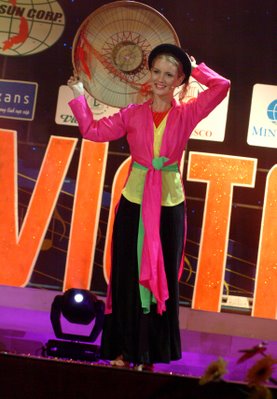

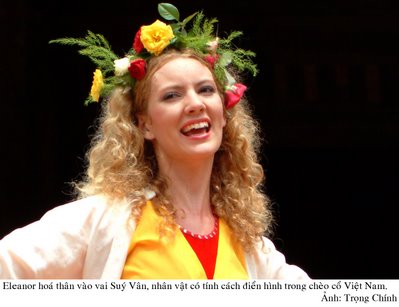





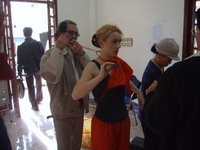
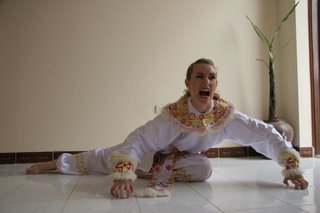
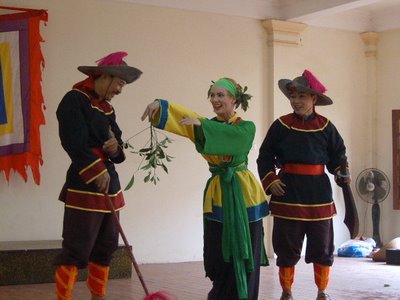
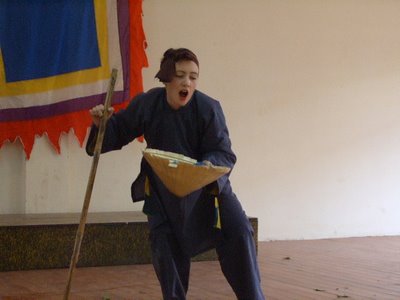
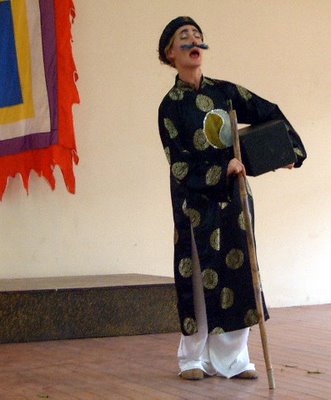

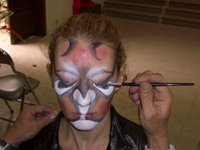
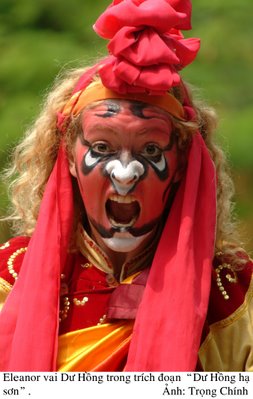
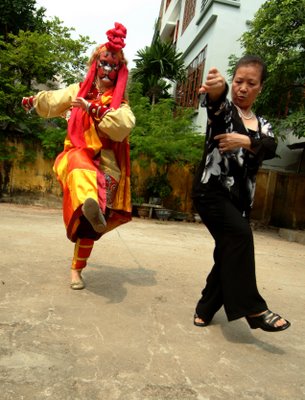



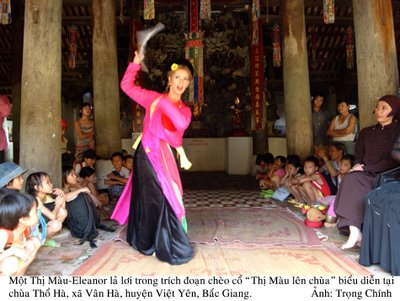


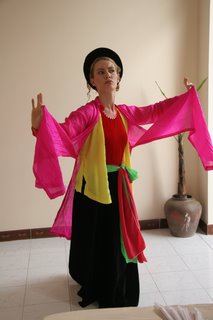
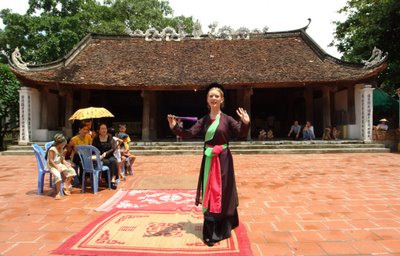
 Suy Van's fate is the saddest of all. Suy Van, like Thi Kinh, is an honourable woman. But when her husband returns from study he tells her that he must take an other wife. Refusing to share her husband Suy Van decides to pretends to be crazy so that her husband will divorce her. That way she can marry a marry that already admires her. But Suy Van is tricked, the man she intends to marry is a folouderer and is only out to use Suy Van.
Suy Van's fate is the saddest of all. Suy Van, like Thi Kinh, is an honourable woman. But when her husband returns from study he tells her that he must take an other wife. Refusing to share her husband Suy Van decides to pretends to be crazy so that her husband will divorce her. That way she can marry a marry that already admires her. But Suy Van is tricked, the man she intends to marry is a folouderer and is only out to use Suy Van.